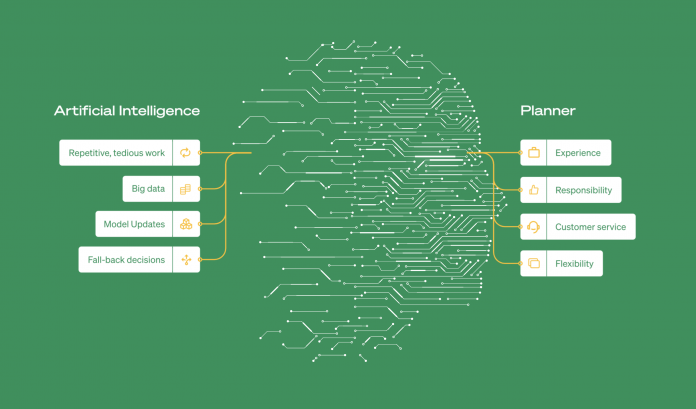Artificial Intelligence (AI) and Big Data play pivotal role in optimizing various aspects of the logistics industry. Transmetrics, co-founded by industry veteran Asparuh Koev, employs AI to forecast container demand, reducing costs significantly. These technologies enhance supply chain visibility, improve fleet management through predictive maintenance, and optimize demand forecasting and inventory management.
Koev told Container News how AI and Big Data can support logistics operations and improve processes in the industry.
1. How can AI be utilized to optimize route planning and logistics operations?
Transmetrics utilizes AI to address major shipping challenges, such as empty container repositioning. Transmetrics’ proprietary AI optimizes the relocation of empty containers by forecasting container demand on global and granular levels up to 12 weeks in advance, reducing the required container fleet by up to 7%. This cuts storage costs for empty containers by up to 30% and decreases logistics costs by up to 12%. Many other prominent players utilize AI to predict vessel arrival times, coordinate inbound and outbound flows, and forecast equipment workload to minimize port congestion.
2. In what ways can Big Data analytics improve supply chain visibility?
The supply chain industry of today generates vast quantities of data. Big Data analytics provides the capability to leverage this data and make the correct decisions based on data-driven and unbiased insights. This enhances visibility by providing a real-time outlook into inventory levels, production, and the logistics behind it all, reducing the risk of disruptions and enhancing overall supply chain efficiency.
3. How might AI-driven predictive maintenance enhance fleet management?
AI-driven predictive maintenance analyzes telematics and Internet of Things (IoT) data from vehicles, including usage patterns and performance metrics. Analyzing many variables, such as tire pressure changes, terrain, and acceleration/braking frequency, predicts potential breakdowns before they occur. Furthermore, fleet managers can observe the condition of each unit of their fleet to schedule proactive maintenance, minimizing downtime and reducing overall maintenance costs. It can also ensure that your fleet runs smoothly during the peak periods.
4. Can AI and Big Data contribute to demand forecasting and inventory management?
This is where the contribution of AI and Big Data will be the most important and tangible if we talk about enhancing operational efficiency. The supply chain, in its essence, is an industry that relies on seasonality. Given this and the abundance of historical data, the sector can fully leverage big data and demand forecasting to predict what is coming ahead and be prepared to meet the upcoming demand. At Transmetrics, we can enhance this approach even further by combining the historical data with the relevant external factors (weather, holidays, consumer sentiment, etc.), resulting in 90%+ accuracy in demand forecasting.
Organizations can leverage such demand predictions for optimized inventory management, preventing stock-outs or overstock situations and obtaining unprecedented visibility on global, local, and even location levels.
5. In what ways can AI enhance the efficiency of warehouse operations?
AI improves warehouse efficiency by automating routine tasks, optimizing inventory placement, and streamlining order fulfillment processes. Robotics and machine learning contribute to faster and more accurate order picking, reducing operational costs and improving warehouse productivity.
6. How can AI be applied to enhance the security and risk management of logistics operations?
AI can enhance security by analyzing data to detect real-time anomalies or potential threats. It can be applied to monitor the movement of goods, identify security risks, and ensure compliance with safety protocols. AI-driven risk management systems help mitigate potential risks and enhance the overall security of logistics operations.
7. How might Big Data be used to improve supplier relationships and collaboration?
Big Data enables better collaboration by providing insights into supplier performance, lead times, and order fulfillment. This information fosters stronger relationships, improves communication, and allows for more effective collaboration between logistics providers and suppliers, leading to a more streamlined and efficient supply chain.
8. Can AI help in sustainability efforts within the logistics industry?
Absolutely. Efficiency and sustainability go hand in hand in logistics. Therefore, AI contributes to sustainability efforts by making operations more efficient and increasing asset utilization. It results in fewer empty kilometers traveled by trucks and reduces the fleet needed to satisfy the same demand. Additionally, AI-driven analytics can identify opportunities for energy efficiency, resource optimization, and waste reduction throughout the logistics process.
9. In what ways can AI and big data address regulatory compliance challenges in logistics?
AI and Big Data assist in monitoring and ensuring compliance with various regulations by tracking and analyzing transportation, storage, and documentation data. Automated systems can flag potential compliance issues, reducing the risk of legal consequences and improving adherence to industry regulations.
10. What dangers may AI technology pose, such as data theft?
While AI brings transformative benefits, there are concerns about data security. It’s crucial to implement robust cybersecurity measures to safeguard sensitive information. AI systems should be designed with privacy in mind, incorporating encryption and access controls to prevent data theft or unauthorized access. Ongoing vigilance and adherence to security best practices are essential to mitigate these potential risks.







